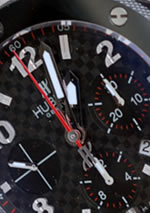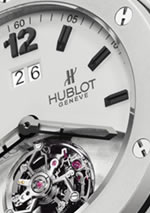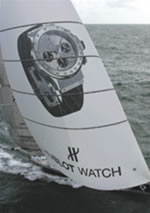
The creator of the gold Hublot was grown up in an Italian family of watchmakers. It was around1967 when he designed his first watch.
In 1980 he established his own company, MDM Geneva, and his aim was to create a watch that would be popular and seek all over the world. He sought to design a watch with a sporting style, yet elegant and fashionable.
Trying to ignore any trend, he created a very elegant sporting watch with an extremely sensitive chosen materials, which could be wearing anytime, anywhere.
He followed the belief that the key to success was simplicity and he modeled his look on a ship's porthole. His lunette is secured to the case by twelve titanium screws. They mark the hours in a mixture of form and function.
Rubber caught the attention of watch making brands in the mid-90s. This proved the validity of the materials chosen for the creation of Hublot watches and their status and reputation was gained as great classics.
After three years of research it was possible to design and produce a bracelet and highlight the outstanding properties of natural rubber that seems to regenerate after being in contact with the skin daily.
The sensation that a customer has when the two strands are strapped to the wrist is amazing. It immediately adapts to the wrist and it reflects an extraordinary lightens and comfort.
The rubber bracelet is nowadays the only used on Hublot watches and it seems to be the only option and possible choice from now onwards.
The Hublot black natural rubber bracelet features an incredible porthole-shaped case, combination of brushed and polished metal, together with the black dial.
The impressive look of this timepiece is even highlighted by a covering mount that highlights the image of the porthole.
Royalty as well as a huge amount of celebrities worldwide, become fond of Hublot watches. It was a few years later that Hublot enterer the exclusive and elitist circle of great Swiss making watches brands. 
Hublot began what was the last independent family watch making business, a family firm by essence, following a mono-product concept, always maintaining its independence an awesome personality.
Limited series collections, with a variety of dials in chased enamel and bas-reliefs, covers preciously engraved, inset or enameled, are the result of Hublot's master and outstanding craftsmen. It is due to them and their meticulous attention given to every single detail that the limited series collection was created. These talented craftsmen in each specialty help in the production of made-to-measure pieces which enrich an revalue the Hublot Art Collection".
Carlos Crocco decided to look for the right person to lead his watch making house since his multiple activities for the Foundation MDM to help underprivileged children all over the world kept his busy most of the time.
Jean-Claude Biver is one of men to have made his mark on Swiss watch making. Having been born in Luxembourg in 1949, he and his family moved to Switzerland when he was 10.
He attended school at theSaint-Prex. He later followed his studies at the Collège de Morges and University of Lausanne. He arrived at Brassus with a HEC diploma.
Although the Vallée de Joux was a complicated watch making circle, he was absolutely marked by it.
He eventually moved and he built up his house near a farm that some years later would become Blancpain's head office. He got married in 1979.
Jean-Claude Biver had a clear aim in his life: he set his mind to learn as much as he could from Audemars Piguet in 1975. In 1981, he and his friend Jacques Piguet, bought up the Blancpain  business, which had been out of production.
business, which had been out of production.
The two friends and partners decided to keep and save the brand's identity by returning to the origins and traditions at a time when quartz was its highest wave of success.
The Blanpain was given birth by this concept. However success was not an easy thigh to get and it did not came right away.
That year, watch making was undergoing a crisis. Jean-Claude Biver believed that everything had to go badly for people to start thinking about creating something new. He thought that the Blancpain had become and object of outstanding attention.
Ten years after the Balncpain was created, the company was already launched and extremely successful.
But the two partners decided to sell it, even though it was successful. They wanted to protect the business.
In 1992 Nicolas Hayek and the Swatch Group bought up Blancpain.
Jean-Claude Biver remained in the company as a boss as well as a member of the Swatch Group Directors' Committee until 2003, year in which he decided to take a sabbatical year to rest and relax.
Carlo Crocco realized that he was the man for the position. 
Therefore, instead of the year off he had thought of, in 2004, Biver was on the post of CEO and board member of Hublot. He had several projects for the development of the house, including the launch of the Fusion, which illustrated Hublot's new objective.
In 1980, the engagement between gold and rubber gave birth to a unique watch, the Hublot.
It was twenty five years later that the brand decided to reinterpret its DNA and it went back to its first principles. The brand fashioned though the traditional art of watch making.
Putting together rare material such as ceramics and gold, pink or gold titanium and rubber. And this fusion brought together movements of Swiss traditions with the XXI century art of watch making - while keeping the unique Hublot feeling for watch design.





No comments:
Post a Comment